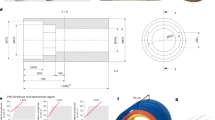Abstract
Echo-planar imaging (EPI) is a snapshot technique, which is useful in a wide range of clinical applications, including the study of physiological function. Over recent years, EPI has found a major new use in functional imaging of the brain. Many EPI experiments can benefit from the increased signal-to-noise ratio (S/N) which results from imaging at high magnetic field. Recently, we have built a 3.0-T EPI scanner at Nottingham University. The low-level radiofrequency and control electronics have been constructed in-house. This, coupled with software written specifically for the system, results in a performance and flexibility exceeding that of a commercial system. A quiet head gradient set produces gradients of up to 30 mT m−1. It is driven using a series multiresonant filter circuit, which allows the production of high-strength, trapezoidal- or sinusoidal-switched gradients.
Using this scanner it has been possible to obtain images comprising 256×256 pixels, with a 2.5-mm slice and 0.75 mm in-plane resolution, in 140 ms. Multislicing allows a volume set of 16,128×128 images to be obtained in 1.6 s. A comparison of tests performed at fields of 0.5 T and 3.0 T on the same phantom indicates a better than linear increase in S/N with field strength. EPI images obtained at 3.0 T have been used in studies of brain activation during visual stimulation and execution of a simple motor task.
Similar content being viewed by others
References
Mansfield P (1977) Multi-planar image formation using NMR spin echoes.J Phys [E] 10 55–62.
Mansfield P, Coxon R, Glover P (1994) Echo-planar imaging of the brain at 3.0 T: first normal volunteer results.Journal of Computer Assisted Tomography 18 339–343.
Belliveau JW, Kennedy DN, McKinstry RC, Buchbinder BR, Weisskoff RM, Cohen MS, Vevea JM, Brady TJ, Rosen BR (1991) Functional mapping of the human visual cortex by Magnetic Resonance Imaging.Science 254 716–719.
Bandettini PA, Wong EC, Hinks RS, Tikofsky RS, Hyde JS (1992) Time course EPI of human brain function during task activation.Magn Reson Med 25 390–397.
Ogawa S, Lee TM, Nayak AS, Glynn P (1990) Oxygen-ation-sensitive contrast in magnetic resonance images of rodent brain at high fields.Magn Reson Med 14 68–78.
Turner R, Jezzard P, Wen H, Kwong KK, Le Bihan D, Zeffiro T, Balaban RS (1993) Functional mapping of the human visual cortex at 4 and 1.5 Tesla using deoxygen-ation contrast EPI.Magn Reson Med 29 277–279.
Glover PM (1993) High field magnetic resonance imaging.Ph.D. Thesis, University of Nottingham.
Mansfield P, Glover PM, Bowtell R (1994) Active acoustic screening: design principles for quiet gradient coils in MRI.Meas Sci Technol 5 1021–1025.
Mansfield P, Chapman BLW, Bowtell R, Glover PM, Harvey P (1994) Active acoustic screening: reduction of noise in gradient coils by net Lorentz force balancing.Magn Reson Med (in press).
Mansfield P, Harvey PR (1993) Limits to neural stimulation in echo-planar imaging.Magn Reson Med 29 746–758.
Mansfield P, Harvey PR, Coxon R (1991) Multi-mode resonant gradient coil circuit for ultra high speed NMR imaging.Meas Sci Technol 2 1051–1058.
Glover P, Coxon R, Mansfield P (1993) Echo-planar imaging at 3.0 T.Book of Abstracts of the 10th Annual Meeting of the European Society for Magnetic Resonance in Medicine and Biology, Rome. p. 46.
Mansfield P, Morris PG (1982)NMR Imaging in Biomedicine. New York: Academic Press.
Cohen MS, Weisskoff RM (1991) Ultra-fast imaging.Magn Reson Imag 9 1–37.
Hykin J, Bowtell R, Glover P, Coxon R, Gowland P, Worthington B, Blumhardt, Mansfield P (1994) Functional brain imaging using EPI at 3.0 T.MAGMA 2 (this issue).
Chang H, Fitzpatrick JM (1992) A technique for accurate magnetic resonance imaging in the presence of field inhomogeneities.IEEE Trans Med Imaging MI-11 319–329.
Bowtell R, Mclntyre DJO, Commandre MJ, Glover PM, Mansfield P (1994)Proceedings of the 2nd Annual Meeting of the Society of Magnetic Resonance, San Francisco (p 411).
Author information
Authors and Affiliations
Rights and permissions
About this article
Cite this article
Bowtell, R., Mansfield, P., Coxon, R.J. et al. High-resolution echo-planar imaging at 3.0 T. MAGMA 2, 241–245 (1994). https://doi.org/10.1007/BF01705247
Issue Date:
DOI: https://doi.org/10.1007/BF01705247




